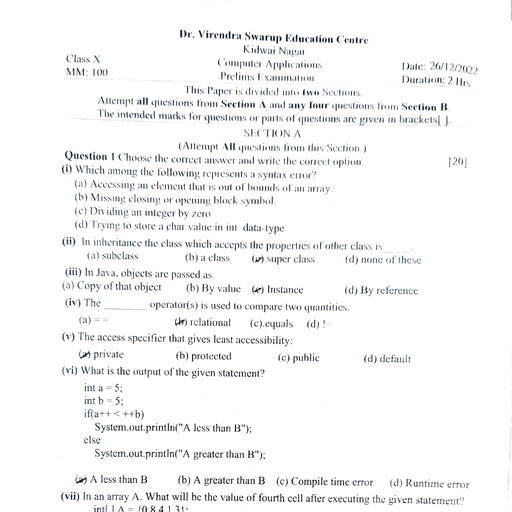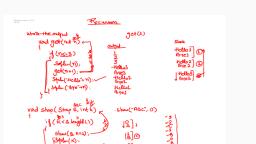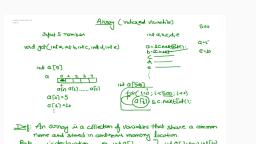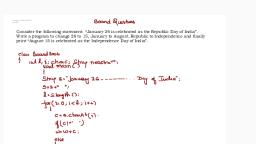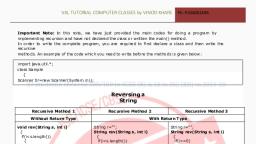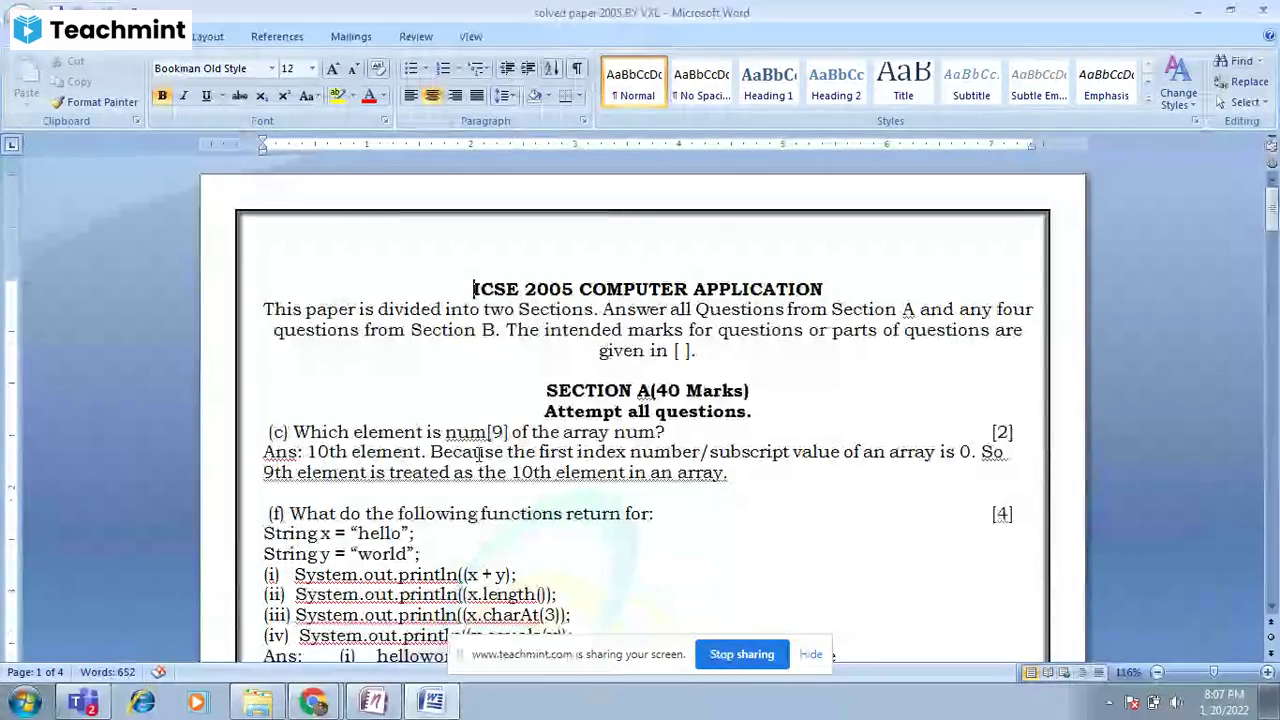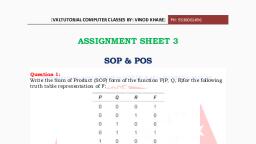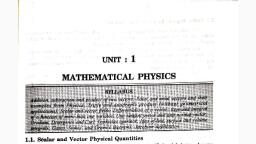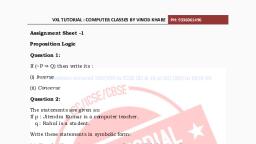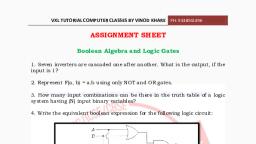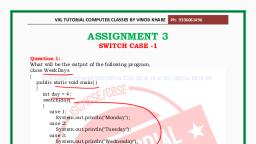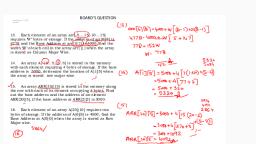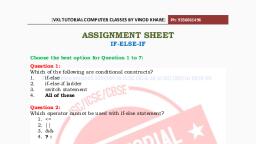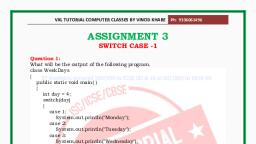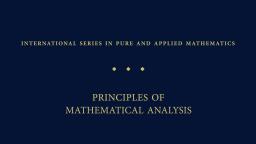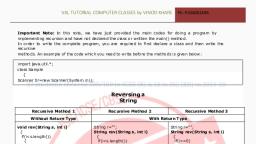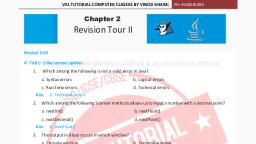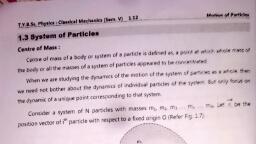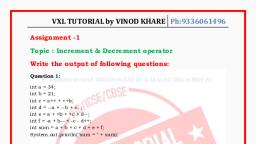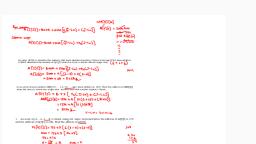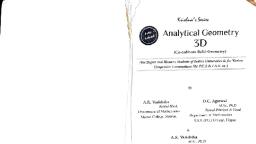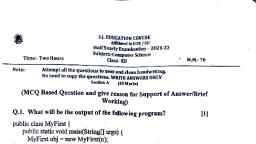Page 2 :
[VXLTUTORIAL COMPUTER CLASSES BY: VINOD KHARE] PH: 9336061496, Answer 3:, , To get the POS form, we need to product maxterms for all those input, combinations that produce output as 0., Thus, P +, Answer 4:, , Answer 5:, , .R = (P +Q + R).(P +, , + R).(P +, , +, , )
Page 3 :
[VXLTUTORIAL COMPUTER CLASSES BY: VINOD KHARE] PH: 9336061496, Answer 6:, The associative law states:, (i) X + (Y + Z) = (X + Y) + Z, (ii) X.(Y.Z) = (X.Y).Z, Verification:, Truth table of X+ {Y + Z) = (X+ Y) +Z, , Answer 7:
Page 6 :
[VXLTUTORIAL COMPUTER CLASSES BY: VINOD KHARE] PH: 9336061496, , Answer 11:, A, , B, , C, , D, (Output), , Max, Terms, , Max Term, Designation, , 0, , 0, , 0, , 0, , A+B+C, , M0, , 0, , 0, , 1, , 0, , A+B+C', , M1, , 0, , 1, , 0, , 0, , A+B'+C, , M2, , 0, , 1, , 1, , 1, , 1, , 0, , 0, , 0, , A'+B+C, , M4, , 1, , 0, , 1, , 1, , 1, , 1, , 0, , 1, , 1, , 1, , 1, , 1, , ** Max term expression for D = (A+B+C).(A+B+C').(A+B'+C).(A'+B+C), ** Max term expression in cardinal form:, F(A, B, C) = π(0, 1, 2, 4), Answer 12:, A, , B, , C, , Output, , 0, , 0, , 0, , 0, , 0, , 0, , 1, , 0, , 0, , 1, , 0, , 0, , 0, , 1, , 1, , 1, , 1, , 0, , 0, , 0, , 1, , 0, , 1, , 1, , AB'C, , 1, , 1, , 0, , 1, , ABC', , 1, , 1, , 1, , 1, , ABC, , SOP expression for F (A, B, C):, A'BC + AB'C + ABC' + ABC, , Min Terms, , A'BC
Page 7 :
[VXLTUTORIAL COMPUTER CLASSES BY: VINOD KHARE] PH: 9336061496, Answer 13:, A, , B, , C, , F, , Max, Terms, , 0, , 0, , 0, , 0, , A+B+C, , 0, , 0, , 1, , 1, , 0, , 1, , 0, , 0, , 0, , 1, , 1, , 1, , 1, , 0, , 0, , 0, , 1, , 0, , 1, , 1, , 1, , 1, , 0, , 0, , 1, , 1, , 1, , 1, , A+B'+C, , A'+B+C, , A'+B'+C, , ** SOP expression:, (A+B+C).(A+B'+C).(A'+B+C).(A'+B'+C), Answer 14:, Truth Table, P, , Q, , R, , Output, , Min, Terms, , Max, Terms, , 0, , 0, , 0, , 1, , P'Q'R', , 0, , 0, , 1, , 0, , P+Q+R', , 0, , 1, , 0, , 0, , P+Q'+R, , 0, , 1, , 1, , 1, , 1, , 0, , 0, , 0, , 1, , 0, , 1, , 1, , PQ'R, , 1, , 1, , 0, , 1, , PQR', , 1, , 1, , 1, , 0, , P'QR, P'+Q+R, , P'+Q'+R', , ** SOP expression = P'Q'R' + P'QR + PQ'R + PQR', ** POS expression = (P+Q+R').(P+Q'+R).(P'+Q+R).(P'+Q'+R')
Page 8 :
[VXLTUTORIAL COMPUTER CLASSES BY: VINOD KHARE] PH: 9336061496, ** Complement of P'Q'R' + P'QR + PQ'R + PQR', = [P'Q'R' + P'QR + PQ'R + PQR']', = (P'Q'R')'.(P'QR)'.(PQ'R)'.(PQR')', = (P''+Q''+R'').(P''+Q'+R').(P'+Q''+R').(P'+Q'+R''), = (P+Q+R).(P+Q'+R').(P'+Q+R').(P'+Q'+R), Answer 15:, Expression in canonical POS form:, (X' + Y' + ZZ').(XX' + Y + Z'), = (X' + Y' + Z).(X' + Y' + Z').(X + Y + Z').(X' + Y + Z'), Answer 16:, ** Maxterm:, A' + B + C' + D', ** Minterm:, A . B' . C . D, Answer 17:, Binary of 0 is 0000: L+M+O+P, Binary of 2 is 0010: L+M+O'+P Binary of 8 is 1000: L'+M+O+P, Binary of 10 is 1010: L'+M+O'+P, Canonical form:, (L+M+O+P).(L+M+O'+P).(L'+M+O+P).(L'+M+O'+P), Reducing the expression using boolean laws:, (L+M+O+P).(L+M+O'+P).(L'+M+O+P).(L'+M+O'+P), = (L+M+O+P).(L'+M+O+P).(L+M+O'+P).(L'+M+O'+P), = [(M+O+P) + (LL')].[(M+O'+P) + (LL')], = [(M+O+P) + 0].[(M+O'+P) + 0], = (M+O+P).(M+O'+P), = (M+P) + (O.O'), = M+P+0, = M+P, , [Associative Law], [Distributive Law], [Complementary Law], [∵ a+0=a], [Distributive Law], [Complementary Law], [∵ a+0=a], , Answer 18:, Computers understand machine language which is based on binary logic i.e., 0's and 1's. Their eletrical circuits are a physical manifestation of two-value, Boolean logic. The processors of the computer work on boolean algebra.
Page 9 :
[VXLTUTORIAL COMPUTER CLASSES BY: VINOD KHARE] PH: 9336061496, Answer 19:, ** Converting to max term designation:, Binary Pattern of max term (X' + Y + Z') = 101, Decimal Equivalent of 101 = 5, Max term designation of (X' + Y + Z') = M5, Binary Pattern of max term (X + Y' + Z) = 010, Decimal Equivalent of 010 = 2, Max term designation of (X + Y' + Z) = M2, Binary Pattern of max term (X + Y + Z') = 001, Decimal Equivalent of 001 = 1, Max term designation of (X + Y + Z') = M1, Binary Pattern of max term (X + Y + Z) = 000, Decimal Equivalent of 000 = 0, Max term designation of (X + Y + Z) = M0, Max term designation = M0, M1, M2, M5, Min term designation = m3, m4, m6, m7, m3 = 011 = X'YZ, m4 = 100 = XY'Z', m6 = 110 = XYZ', m7 = 111 = XYZ, SOP Expression = X'YZ + XY'Z' + XYZ' + XYZ, Answer 20:, A, , B, , C, , D, , R, , 0, , 0, , 0, , 0, , 0, , 0, , 0, , 0, , 1, , 0, , 0, , 0, , 1, , 0, , 0, , 0, , 0, , 1, , 1, , 1, , 0, , 1, , 0, , 0, , 0, , 0, , 1, , 0, , 1, , 0, , 0, , 1, , 1, , 0, , 0, , 0, , 1, , 1, , 1, , 1, , 1, , 0, , 0, , 0, , 0, , Min, Terms, , A'B'CD, , A'BCD
Page 10 :
[VXLTUTORIAL COMPUTER CLASSES BY: VINOD KHARE] PH: 9336061496, , A, , B, , C, , D, , R, , 1, , 0, , 0, , 1, , 0, , 1, , 0, , 1, , 0, , 0, , 1, , 0, , 1, , 1, , 1, , 1, , 1, , 0, , 0, , 0, , 1, , 1, , 0, , 1, , 1, , 1, , 1, , 1, , 0, , 0, , 1, , 1, , 1, , 1, , 1, , Min, Terms, , AB'CD, , ABC'D, , ABCD, , ** SOP expression:, A'B'CD + A'BCD + AB'CD + ABC'D + ABCD, ** Reduced SOP = ABD + CD, Answer 21:, :, Min Terms, P, , Q, , R, , X'Y'Z, , X'Y'Z, , X'Y'Z, , X'YZ', , X'YZ', , X'YZ, , X'YZ, , XY'Z', XY'Z, , XY'Z, , XYZ', XYZ, ** SOP for P:, X'Y'Z + X'YZ' + X'YZ + XY'Z', ** SOP for Q:, X'Y'Z + X'YZ' + XY'Z + XYZ'
Page 11 :
[VXLTUTORIAL COMPUTER CLASSES BY: VINOD KHARE] PH: 9336061496, ** SOP for R:, X'Y'Z + X'YZ + XY'Z + XYZ, K-Map for P:, From Pair (1,3):, Rows representing the Pair: X', Columns representing the Pair: Y'Z + YZ = Z, Term Obtained = X'Z, From Pair (3,2):, Rows representing the Pair: X', Columns representing the Pair: YZ + YZ' = Y, Term Obtained = X'Y, From (4):, Rows representing (4): X, Columns representing (4): Y'Z', Term Obtained = XY'Z', Reduced Expression for P = XY'Z' + X'Y + X'Z, K-Map for Q:, From Pair (1,5):, Rows representing the Pair: X' + X = 1, Columns representing the Pair: Y'Z, Term Obtained = Y'Z, From Pair (2,6):, Rows representing the Pair: X' + X = 1, Columns representing the Pair: YZ', Term Obtained = YZ', Reduced Expression for Q = Y'Z + YZ', K-Map for R:, From Quad (1,3,5,7):, Rows representing the Quad: X' + X = 1, Columns representing the Quad: Y'Z + YZ = Z, Term Obtained = Z, Reduced Expression for R = Z, Answer 22:, Canonical sum of product form:, X'Y'Z' + X'Y'Z + XY'Z + XYZ, Answer 23:, ** Dual of P'QR' + PQ'R + P'Q'R:, (P'+Q+R').(P+Q'+R).(P'+Q'+R), ** Complement of PQ'R + Q.(P'R' + PR'):
Page 12 :
[VXLTUTORIAL COMPUTER CLASSES BY: VINOD KHARE] PH: 9336061496, [PQ'R+Q.(P'R'+PR')]', = (PQ'R)'.[Q.(P'R'+PR')]', = (P'+Q+R').[P'QR'+PQR']', = (P'+Q+R').(P+Q'+R).(P'+Q'+R), Hence proved., Answer 24:, In POS expression, a sum term of n variables in which each of the n variables, appear once in either its complement or uncomplement form is known as Max, term., Converting into product of maxterms:, (P + Q).(P' + R'), = (P + Q + RR').(P' + QQ' + R'), = (P + Q + R).(P + Q + R').(P' + Q + R').(P' + Q' + R'), Answer 25:, Simplifying the expression:, (X.Y + Z)(Y + Z'.X), = (X + Z).(Y + Z).(Y + Z').(X + Y), = (XY + YZ + XZ + Z).(Y + Z').(X + Y), = [XY + YZ + Z(X + 1)].(Y + Z').(X + Y), = (XY + YZ + Z).(Y + Z').(X + Y), = (XY + YZ + YZ + XYZ' + YZZ' + ZZ').(X + Y), = [XY(1 + Z') + YZ + 0 + 0].(X + Y)*, = (XY + YZ).(X + Y), = XY + XYZ + XY + YZ, = XY(1 + 1 + Z) + YZ, = XY + YZ, Converting to canonical POS form:, XY + YZ, = Y(X + Z), = (Y + XX' + ZZ').(X + YY' + Z), = (X + Y + Z).(X + Y + Z').(X' + Y + Z).(X' + Y + Z').(X + Y + Z).(X + Y' + Z), = (X + Y + Z).(X + Y + Z').(X' + Y + Z).(X' + Y + Z').(X + Y' + Z), Answer 26:, F(a, b, c) = π(2, 3, 4, 7), Reducing using K-Map:, From Pair (3,2):, Rows representing the Pair: a, Columns representing the Pair: (b'+c').(b'+c) = b', Term Obtained = a+b', From Pair (3,7):, Rows representing the Pair: 1 (Both a and a' cancel each other)
Page 13 :
[VXLTUTORIAL COMPUTER CLASSES BY: VINOD KHARE] PH: 9336061496, Columns representing the Pair: b'+c', Term Obtained = b'+c', From (4):, Row representing (4): a', Columns representing (4): b+c Term Obtained = a'+b+c, Reduced Expression = (a + b').(b' + c').(a' + b + c), F(a, b, c) = Σ(0, 1, 5, 6), Reducing using K-Map:, From Pair (0,1):, Rows representing the Pair: a', Columns representing the Pair: b'c' + b'c = b', Term Obtained = a'b', From Pair (1,5):, Rows representing the Pair: 1 (Both a and a' cancel each other), Columns representing the Pair: b'c, Term Obtained = b'c, From (6):, Row representing (6): a, Columns representing (6): bc' Term Obtained = abc', Reduced Expression = a'b' + b'c + abc', To prove:, (a + b').(b' + c').(a' + b + c) = a'b' + b'c + abc', LHS = (a' + b + c).(a + b').(b' + c'), = (aa' + a'b' + ab + bb' + ac + b'c).(b' + c'), = (a'b' + ab + ac + b'c).(b' + c'), = a'b'b' + a'b'c' + abb' + abc' + ab'c + acc' + b'b'c + b'cc', = a'b' + a'b'c' + 0 + abc' + ab'c + 0 + b'c + 0, = a'b' + a'b'c' + abc' + ab'c + b'c, = a'b'(1 + c') + abc' + b'c(a + 1), = a'b' + abc' + b'c, = RHS, Hence Proved.
Page 14 :
[VXLTUTORIAL COMPUTER CLASSES BY: VINOD KHARE] PH: 9336061496, Answer 27:, High output when even number of low inputs or even number of high inputs,, i.e.



